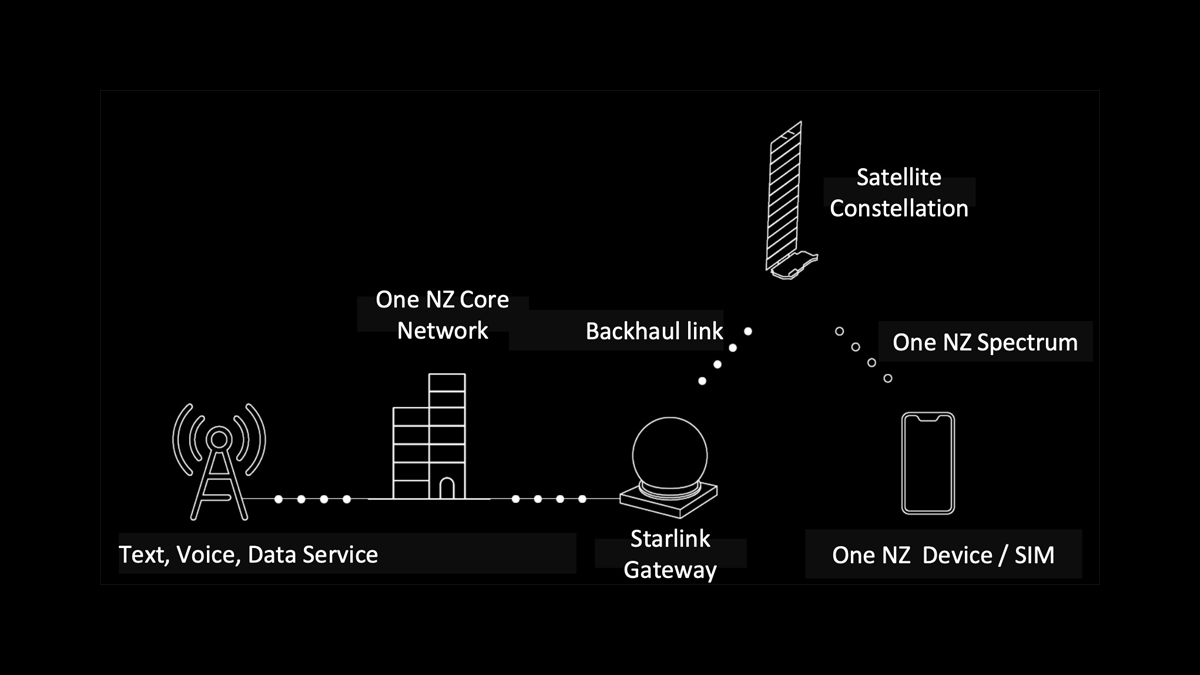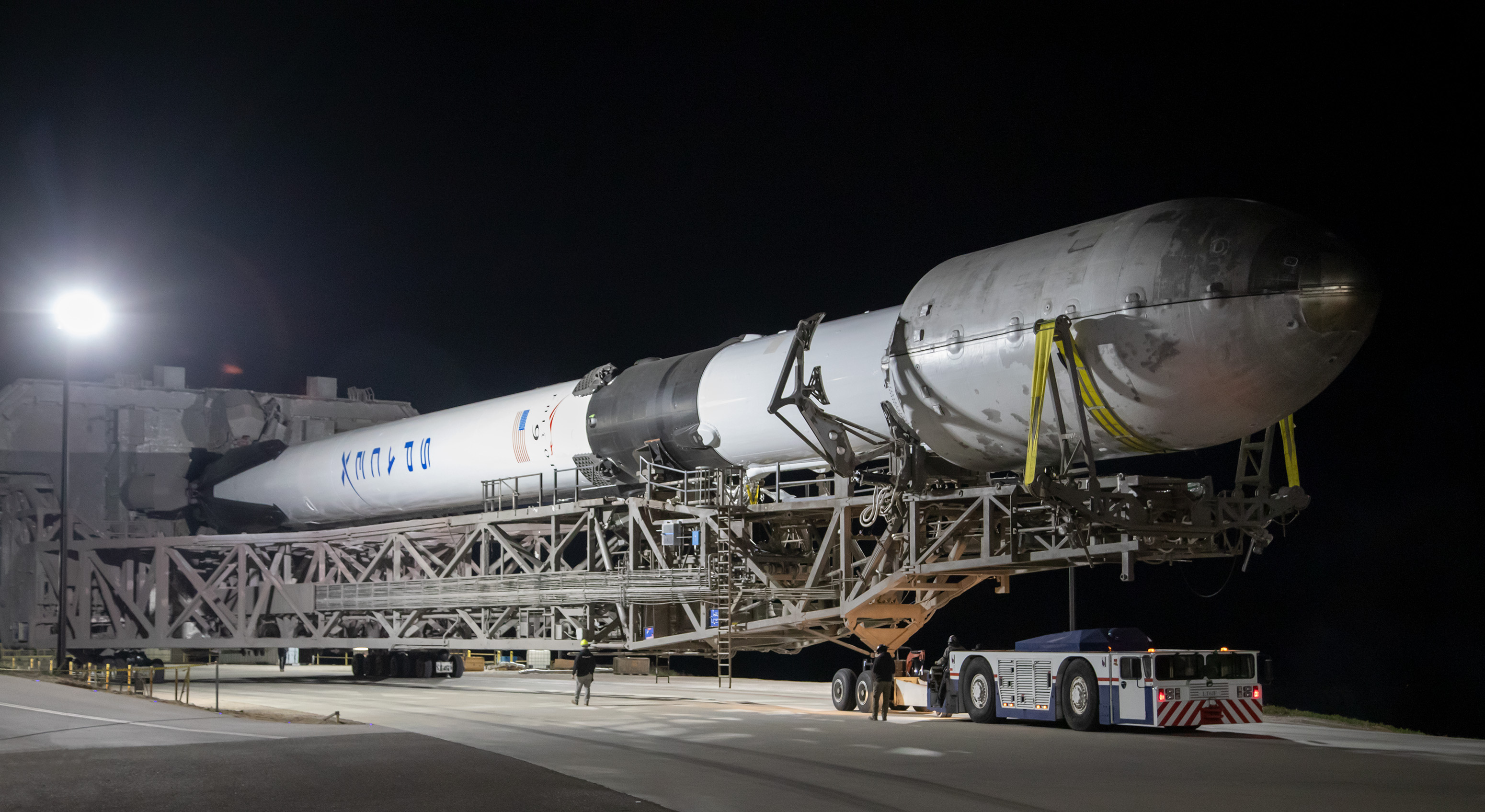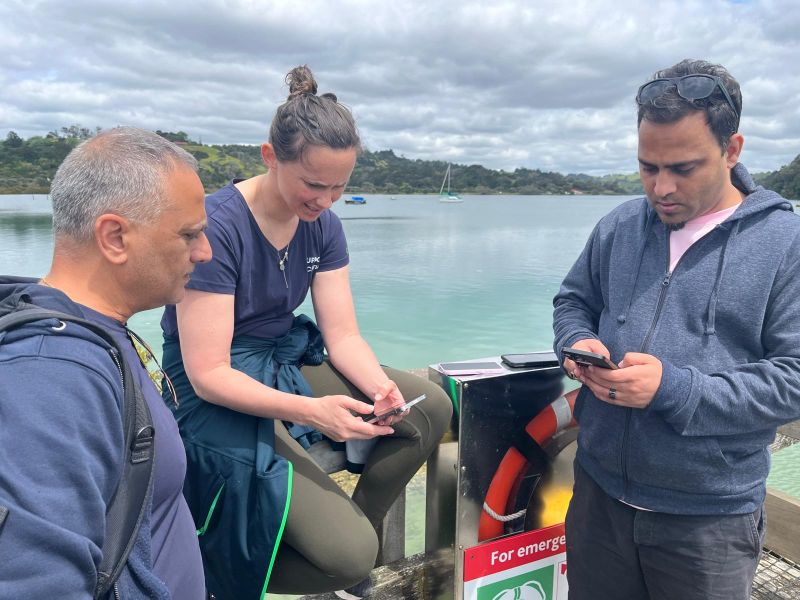
One NZ's mobile phone service from the skies, using SpaceX's Starlink satellites is one step closer with the successful launch last week of the Falcon 9 rocket. This deployed 20 new Starlink satellites at 295 kilometres altitude; 13 of these are what SpaceX calls Direct to Cell (D2C) capable. A further two launches are required for a working D2C satellite constellation that telco subscribers can use.
This means it's possible for normal mobile phones to communicate directly over the satellites. It's quite a technological feat, considering the Starlink satellites fly past at 27,000 kilometres an hour, meaning phones only have a short window of time to connect to each "bird" before handover to another one takes place using intra-satellite laser links and a proprietary SpaceX communications protocol.
D2C Starlink satellites essentially act as mobile phone towers in the sky. What makes the D2C service possible using regular mobile phones is the relatively low orbit, some 550-600 kilometres away from the ground. This is known as Low Earth Orbit (LEO) satellites, as opposed to geostationary orbit which is around 38,000 kilometres in space.
LEO satellites' shorter distance away from users means there's far less signal transmission delay compared to GEO equivalents; Starlink is somewhere in the 30 to 60 millisecond range latency, whereas GEO satellites is 240 to 280 ms; long story short, the lower the latency, the better the user experience. Ask any online gamer and they'll tell you what "low ping times" mean.
There is a trade-off of course: each Starlink satellite has a relatively small amount of ground coverage, and for a short period of time only as it zooms past ground terminals. This is the reason for the huge constellations, with just under 6500 satellites currently (not all of which are working), with more to come.
And that's the main reason for One NZ signing up for the Starlink D2C "service rideshare" model: coverage. Currently, One NZ covers 60 per cent of New Zealand's landmass with its terrestrial network. Supplemented by Starlink D2C, that should cover much more, closer to all of the country (we won't say "100 per cent" as the regulator took umbrage to that), reaching 12 nautical miles off shore which will be attractive for fishers. All without building expensive, power hungry cell sites on land, and maybe even getting low-band spectrum management rights for them.
While the One NZ service won't work in places where the satellite signal (which is boosted compared to what the terrestrial networks provide) can't penetrate like inside buildings, it should work in cars. One NZ is eyeing up the logistics market and IoT service subscriptions for areas that are difficult to reach with normal cellular service from land-based towers.
No updates to phones
The D2C service follows the mobile phone industry association 3GPP's standards, and run in the 1800 MHz frequency band, providing Long Term Evolution (LTE) 4G service. One NZ has committed two 5 MHz channels (10 MHz in total) of bandwidth in the 1800 MHz spectrum to the service, which may not seem much; in November last year, One NZ was able to buy two 35 MHz wide channels in the 2600 MHz band from Dense Air which was exiting New Zealand, a total of 70 MHz spectrum that the telco added to its 5G service.
As a side note, it's probably galling for One NZ which had to pay big money to get management rights for the spectrum it users for mobile service in government auctions to look at SpaceX which got the satellite uplinks for just a $150 admin charge each. Currently, SpaceX has six Earth stations for Starlink, with another six to be built.
This is the first iteration of One NZ's D2C service over Starlink, and the telco's general manager of networks, Thaigan Govender explained the initial offering will support texting, with more services such as connectivity for Internet of Things (IoT) devices arriving next year, along with basic data and perhaps even voice calls.
It is in fact not the first use of Starlink for One NZ, which utilises the satellites for data transmission backhaul already.
As the Starlink D2C constellation grows, the two-minute or so delay between messages that the Commerce Commission is concerned about should disappear, with latency dropping down to more user-friendly levels along the lines of One NZ's land-based mobile network.

A big deal here is that as we're talking about a 3GPP standard mobile service, Starlink service for One X should work without phones having to be updated. More on this when the service launches, which might be at the very end of this year, or in early 2025, depending on SpaceX.
In fact, 3GPP has a new acronym for you: NTN. That stands for non-terrestrial networks, and covers LEO, MEO, GEO and... HEO. Much more information on NTN plus more acronyms than you can shake a selfie-stick at on the 3GPP site.
One NZ isn't alone in launching the service: Optus in Australia, KDDI in Japan, Rogers in Canada and T-Mobile in the United States have also signed up, along with Salt in Switzerland. Whether or not the initial batch of telcos will offering roaming in each other's service depends on technical capabilities and no doubt, lengthy commercial negotiations. Other telcos around the world will be watching this space carefully, and some have already started working with competing satellite providers, like Vodafone going with AST, and 2degrees and Spark with Lynk.
Lynk's service looks like it could be competitive with SpaceX, but the company is a long way off from the necessary constellation size as of writing.
Apple which recently sank a cool US$1.5 billion into LEO operator Globalstar which currently has a fairly small network of 25 satellites compared to Starlink's thousands, will be interesting to watch: Apple has its proprietary end-to-end encrypted iMessage service to think about, and with enormous amounts of money in the bank the tech giant might invest in making it run over satellites as well.
No extra charges for Starlink D2C on "eligible plans"
One NZ has not said how much it is paying SpaceX for the D2C service, but it is very much a commercial proposition for the telco. For now, the plan seems to be that the top end on-account plans will be eligible to use Starlink D2C without surcharges.
When you're connected to D2C, the banner on your phone will change to "One NZ SpaceX" or similar.
This is a long term commitment for One NZ - Govender mentioned 2030, when 6G is expected to appear - and the telco has puts in heaps of testing to ensure it works.

The Starlink satellites have a roughly five-year lifespan, after which they're de-orbited to burn in the atmosphere. What the SpaceX D2C plans are for upgraded 5G/6G service remain unclear for now as the radio technology is different from 4G, along with the possibility of adding bandwidth to the satellites, in the long-reach 600 MHz spectrum which One NZ is keen to get some rights in.
Other than that, the D2C service is fully legal with approval from communications watchdogs, and with lawful interception capability in New Zealand. Next year will tells us how well it works.
8 Comments
Probably should have already released a list of compatible phones, many people out there could be getting excited for no reason. Not sure that those with phones that don't work are going to rush out and get one that does just to get the occasional missed text. Potentially a great service in the future when they add voice but why do I get the feeling this is still years away.
We're still testing the service and eligible phones, so will release details on that asap. We are also likely going to release plan/pricing details next week. As this is new and evolving tech, we're sharing details as soon as we can - apologies for making everyone wait! But we are super excited about the potential of this tech, and to be one of the first telcos globally to introduce it.
They sold those cell towers off for a reason - watch this space (no pun intended)
walking in the country today and walked outside phone area and my phone linked to the satellite, i didn't try a phone call but for it to link they must have it turned on
Thanks for the heads up, I visit a spot down here in Tauranga once a week called TECT Park. Despite them putting in a new cell tower that is visible from the hilltop, it doesn't seem to work at all and the phone shows zero coverage. Will check my phone next time I'm out there.
The Starlink Service is a technological marvel, but provided by One, who are yet again at the bottom of the satisfaction and compliance measures.
Technical brilliance from a provider who is expensive and offers poor customer service may not persuade people.
Don't have a problem with them myself. I'm on a $45 a month plan and it used to cost more than that now for a copper landline.
Thanks for your comment, and we agree this tech is awesome. We will release details about eligible plans next week, but think we offer pretty great value for money - soon with 24/7 access to coverage right across NZ (including current terrestrial network + space!) and considering we invest hundreds of millions of dollars into our networks each year.
On customer service, we're the only telco who publishes their metrics daily (https://one.nz/contact/) and have made heaps of improvements over the recent few years.
Maybe it's worth giving us another go :-). I'd be happy to play your personal account manager if helpful (nicky.preston@one.nz).

We welcome your comments below. If you are not already registered, please register to comment.
Remember we welcome robust, respectful and insightful debate. We don't welcome abusive or defamatory comments and will de-register those repeatedly making such comments. Our current comment policy is here.